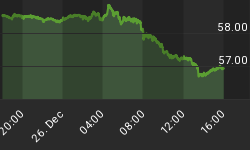Can Bullish Gains Hold This Time?
Wednesday's trading session featured a 32 point zig zag affair intraday that resulted in almost no change vs. Tuesday's session when the final 4 p.m. whistle sounded. Investors were greeted Thursday morning with big gains early in the day fueled by the Federal Reserve, European Central Bank (ECB), and a better than expected report on the labor front.

Lowest Claims In Five Years
The early bullish bias was aided by a report that showed a glimmer of economic hope. From Bloomberg:
Claims for jobless benefits unexpectedly dropped to the lowest level in more than five years, extending swings typical for the month of July. Applications for unemployment insurance payments declined by 19,000 to 326,000 in the week ended July 27, the fewest since January 2008, from a revised 345,000 the prior week, the Labor Department reported today in Washington. The median forecast of 50 economists surveyed by Bloomberg called for 345,000.

Thursday's weekly report will quickly be placed in the rearview mirror with the monthly "employment situation" update coming Friday.
Taper Does Not Mean Raising Rates
As noted prior to Wednesday's Fed announcement, there is little basis for the central bank to begin a traditional campaign of incremental rate increases, which may be seeping into markets in the form of higher stock prices. The Fed delivered as expected and emphasized their calling in life:
"Consistent with its statutory mandate, the Committee seeks to foster maximum employment and price stability."
Price stability is a Goldilocks view of inflation; not too high and not too low. Their statement emphasized concerns about inflation running too low, rather than too high:
"Inflation has been running below the Committee's longer-run objective... The Committee recognizes that inflation persistently below its 2 percent objective could pose risks to economic performance, but it anticipates that inflation will move back toward its objective over the medium term."
Low inflation can slip into a deflationary spiral, where buyers sit on their hands waiting for even lower prices, which speaks to the "risks to economic performance". On the employment front, the Fed continued with their "not there yet" stance:
"The unemployment rate remains elevated."
Rates Are Staying Low
The key portions of the statement highlighted the concept of a highly accommodative monetary policy stance:
"The Committee expects that, with appropriate policy accommodation, economic growth will pick up from its recent pace and the unemployment rate will gradually decline toward levels the Committee judges consistent with its dual mandate. To support continued progress toward maximum employment and price stability, the Committee today reaffirmed its view that a highly accommodative stance of monetary policy will remain appropriate for a considerable time after the asset purchase program ends and the economic recovery strengthens."
Twitter can be a polarizing form of expression, which is a nice way of saying some people hate it. Say what you will about time-wasting tweets, but Twitter does force one to net out their point in 140 characters or less, which is nice for deciphering Fed-speak.

U.S. Investors Lean Bullish
It always takes time for the markets to digest a Fed policy statement and reveal the lasting reaction to it. Based on the weekly chart of the S&P 500 Index below, the read of the Fed appears to be siding with the bulls. Further confirmation would come with a weekly close above 1,667.

ECB Joins Accommodative Party
Not to be outdone by Bernanke & Friends, Mario Draghi gave the markets another monetary pat on the back Thursday. From Reuters:
The European Central Bank left interest rates at a record low 0.5 percent on Thursday and affirmed that they will remain there for some while to come and could yet fall further. Mari Draghi said, "The Governing Council confirms that it expects the key ECB rates to remain at present or lower levels for an extended period of time," affirming last month's first stab at giving forward guidance on rates.
The Godfather Speaks
Due to the seemingly infinite number of inputs to process, experience is a valuable ally in the financial markets. Therefore, when technical analysis veterans speak, we typically listen. Ralph Acampora, the former Director of Technical Research at Kidder Peabody and Prudential Securities, is known as the Godfather of technical analysis.

Mr. Acampora understands the value of monitoring market leadership. When consumer staples lead, it sends up some yellow flags. When mid-cap (Russell Mid Cap) and small-cap (Russell 2000) lead, it is indicative of a bullish acceptance of risk. From the Godfather's Twitter feed:

A Picture Is Worth A 1,000 Words
The graph of small caps (IWM) below shows a new all-time high being made this week, which is what Mr. Acampora referred to in his tweet above.

All things being equal, leadership from technology is also indicative of a healthy environment for risk taking. The chart of the NASDAQ below shows an established and healthy trend, which supports our holding in technology (QQQ).

Investment Implications
If you believe monitoring sector strength is a waste of time, consider the segment below from a July 1 article:
"A weekly S&P 500 close above both 1623 and 1642 would increase our openness to redeploying some cash into stronger areas of the market, such as small-caps (IWM), mid-caps (MDY), banks (KBE), and biotech (IBB)."
Since July 1, the leading ETFs noted above have performed quite well:

In the spirit of Led Zeppelin, on the game plan front The Song Remains The Same as it did on July 15:
As long as the markets continue to favor a risk-on allocation, we will continue to overweight U.S. stocks and leading sectors, such as financials (XLF), technology (QQQ), and small caps (IJR).
















